Binomial probit regression with selected constrained species
Source:R/jSDM_binomial_probit_sp_constrained.R
jSDM_binomial_probit_sp_constrained.RdThe jSDM_binomial_probit_sp_constrained function performs in parallel Binomial probit regressions in a Bayesian framework. The function calls a Gibbs sampler written in 'C++' code which uses conjugate priors to estimate the conditional posterior distribution of model's parameters. Then the function evaluates the convergence of MCMC \(\lambda\) chains using the Gelman-Rubin convergence diagnostic (\(\hat{R}\)). \(\hat{R}\) is computed using the gelman.diag function. We identify the species (\(\hat{j}_l\)) having the higher \(\hat{R}\) for \(\lambda_{\hat{j}_l}\). These species drive the structure of the latent axis \(l\). The \(\lambda\) corresponding to this species are constrained to be positive and placed on the diagonal of the \(\Lambda\) matrix for fitting a second model. This usually improves the convergence of the latent variables and factor loadings. The function returns the parameter posterior distributions for this second model.
Arguments
- burnin
The number of burn-in iterations for the sampler.
- mcmc
The number of Gibbs iterations for the sampler. Total number of Gibbs iterations is equal to
burnin+mcmcfor each chain.burnin+mcmcmust be divisible by 10 and superior or equal to 100 so that the progress bar can be displayed.- thin
The thinning interval used in the simulation. The number of MCMC iterations must be divisible by this value.
- nchains
The number of Monte Carlo Markov Chains (MCMCs) simulated in parallel. If not specified, the number of chains is set to 2.
- ncores
The number of cores to use for parallel execution. If not specified, the number of cores is set to 2.
- presence_data
A matrix \(n_{site} \times n_{species}\) indicating the presence by a 1 (or the absence by a 0) of each species on each site.
- site_formula
A one-sided formula of the form '~x1+...+xp' specifying the explanatory variables for the suitability process of the model, used to form the design matrix \(X\) of size \(n_{site} \times np\).
- site_data
A data frame containing the model's explanatory variables by site.
- trait_data
A data frame containing the species traits which can be included as part of the model. Default to
NULLto fit a model without species traits.- trait_formula
A one-sided formula of the form '~ t1 + ... + tk + x1:t1 + ... + xp:tk' specifying the interactions between the environmental variables and the species traits to be considered in the model, used to form the trait design matrix \(Tr\) of size \(n_{species} \times nt\) and to set to \(0\) the \(\gamma\) parameters corresponding to interactions not taken into account according to the formula. Default to
NULLto fit a model with all possible interactions between species traits found intrait_dataand environmental variables defined bysite_formula.- n_latent
An integer which specifies the number of latent variables to generate. Defaults to \(0\).
- site_effect
A string indicating whether row effects are included as fixed effects (
"fixed"), as random effects ("random"), or not included ("none") in the model. If fixed effects, then for parameter identifiability the first row effect is set to zero, which analogous to acting as a reference level when dummy variables are used. If random effects, they are drawn from a normal distribution with mean zero and unknown variance, analogous to a random intercept in mixed models. Defaults to"none".- beta_start
Starting values for \(\beta\) parameters of the suitability process for each species must be either a scalar or a \(np \times n_{species}\) matrix. If
beta_starttakes a scalar value, then that value will serve for all of the \(\beta\) parameters. Different starting values for each chain can be specified by a list or a vector of lengthnchains, by default the same starting values are considered for all chains.- gamma_start
Starting values for \(\gamma\) parameters that represent the influence of species-specific traits on species' responses \(\beta\),
gamma_startmust be either a scalar, a vector of length \(nt\), \(np\) or \(nt.np\) or a \(nt \times np\) matrix. Ifgamma_starttakes a scalar value, then that value will serve for all of the \(\gamma\) parameters. Ifgamma_startis a vector of length \(nt\) or \(nt.np\) the resulting \(nt \times np\) matrix is filled by column with specified values, if a \(np\)-length vector is given, the matrix is filled by row. Different starting values for each chain can be specified by a list or a vector of lengthnchains, by default the same starting values are considered for all chains.- lambda_start
Starting values for \(\lambda\) parameters corresponding to the latent variables for each species must be either a scalar or a \(n_{latent} \times n_{species}\) upper triangular matrix with strictly positive values on the diagonal, ignored if
n_latent=0. Iflambda_starttakes a scalar value, then that value will serve for all of the \(\lambda\) parameters except those concerned by the constraints explained above. Different starting values for each chain can be specified by a list or a vector of lengthnchains, by default the same starting values are considered for all chains.- W_start
Starting values for latent variables must be either a scalar or a \(nsite \times n_latent\) matrix, ignored if
n_latent=0. IfW_starttakes a scalar value, then that value will serve for all of the \(W_{il}\) with \(i=1,\ldots,n_{site}\) and \(l=1,\ldots,n_{latent}\). Different starting values for each chain can be specified by a list or a vector of lengthnchains, by default the same starting values are considered for all chains.- alpha_start
Starting values for random site effect parameters must be either a scalar or a \(n_{site}\)-length vector, ignored if
site_effect="none". Ifalpha_starttakes a scalar value, then that value will serve for all of the \(\alpha\) parameters. Different starting values for each chain can be specified by a list or a vector of lengthnchains, by default the same starting values are considered for all chains.- V_alpha
Starting value for variance of random site effect if
site_effect="random"or constant variance of the Gaussian prior distribution for the fixed site effect ifsite_effect="fixed". Must be a strictly positive scalar, ignored ifsite_effect="none". Different starting values for each chain can be specified by a list or a vector of lengthnchains, by default the same starting values are considered for all chains.- shape_Valpha
Shape parameter of the Inverse-Gamma prior for the random site effect variance
V_alpha, ignored ifsite_effect="none"orsite_effect="fixed". Must be a strictly positive scalar. Default to 0.5 for weak informative prior.- rate_Valpha
Rate parameter of the Inverse-Gamma prior for the random site effect variance
V_alpha, ignored ifsite_effect="none"orsite_effect="fixed"Must be a strictly positive scalar. Default to 0.0005 for weak informative prior.- mu_beta
Means of the Normal priors for the \(\beta\) parameters of the suitability process.
mu_betamust be either a scalar or a \(np\)-length vector. Ifmu_betatakes a scalar value, then that value will serve as the prior mean for all of the \(\beta\) parameters. The default value is set to 0 for an uninformative prior, ignored iftrait_datais specified.- V_beta
Variances of the Normal priors for the \(\beta\) parameters of the suitability process.
V_betamust be either a scalar or a \(np \times np\) symmetric positive semi-definite square matrix. IfV_betatakes a scalar value, then that value will serve as the prior variance for all of the \(\beta\) parameters, so the variance covariance matrix used in this case is diagonal with the specified value on the diagonal. The default variance is large and set to 10 for an uninformative flat prior.- mu_gamma
Means of the Normal priors for the \(\gamma\) parameters.
mu_gammamust be either a scalar, a vector of length \(nt\), \(np\) or \(nt.np\) or a \(nt \times np\) matrix. Ifmu_gammatakes a scalar value, then that value will serve as the prior mean for all of the \(\gamma\) parameters. Ifmu_gammais a vector of length \(nt\) or \(nt.np\) the resulting \(nt \times np\) matrix is filled by column with specified values, if a \(np\)-length vector is given, the matrix is filled by row. The default value is set to 0 for an uninformative prior, ignored iftrait_data=NULL.- V_gamma
Variances of the Normal priors for the \(\gamma\) parameters.
V_gammamust be either a scalar, a vector of length \(nt\), \(np\) or \(nt.np\) or a \(nt \times np\) positive matrix. IfV_gammatakes a scalar value, then that value will serve as the prior variance for all of the \(\gamma\) parameters. IfV_gammais a vector of length \(nt\) or \(nt.np\) the resulting \(nt \times np\) matrix is filled by column with specified values, if a \(np\)-length vector is given, the matrix is filled by row. The default variance is large and set to 10 for an uninformative flat prior, ignored iftrait_data=NULL.- mu_lambda
Means of the Normal priors for the \(\lambda\) parameters corresponding to the latent variables.
mu_lambdamust be either a scalar or a \(n_{latent}\)-length vector. Ifmu_lambdatakes a scalar value, then that value will serve as the prior mean for all of the \(\lambda\) parameters. The default value is set to 0 for an uninformative prior.- V_lambda
Variances of the Normal priors for the \(\lambda\) parameters corresponding to the latent variables.
V_lambdamust be either a scalar or a \(n_{latent} \times n_{latent}\) symmetric positive semi-definite square matrix. IfV_lambdatakes a scalar value, then that value will serve as the prior variance for all of \(\lambda\) parameters, so the variance covariance matrix used in this case is diagonal with the specified value on the diagonal. The default variance is large and set to 10 for an uninformative flat prior.- seed
The seed for the random number generator. Default to
c(123, 1234)for two chains and for more chains different seeds are generated for each chain.- verbose
A switch (0,1) which determines whether or not the progress of the sampler is printed to the screen. Default is 1: a progress bar is printed, indicating the step (in %) reached by the Gibbs sampler.
Value
A list of length nchains where each element is an object of class "jSDM" acting like a list including :
- mcmc.alpha
An mcmc object that contains the posterior samples for site effects \(\alpha\), not returned if
site_effect="none".- mcmc.V_alpha
An mcmc object that contains the posterior samples for variance of random site effect, not returned if
site_effect="none"orsite_effect="fixed".- mcmc.latent
A list by latent variable of mcmc objects that contains the posterior samples for latent variables \(W_l\) with \(l=1,\ldots,n_{latent}\), not returned if
n_latent=0.- mcmc.sp
A list by species of mcmc objects that contains the posterior samples for species effects \(\beta_j\) and \(\lambda_j\) if
n_latent>0with \(j=1,\ldots,n_{species}\).- mcmc.gamma
A list by covariates of mcmc objects that contains the posterior samples for \(\gamma_p\) parameters with \(p=1,\ldots,np\) if
trait_datais specified.- mcmc.Deviance
The posterior sample of the deviance (\(D\)) is also provided, with \(D\) defined as : \(D=-2\log(\prod_{ij} P(y_{ij}|\beta_j,\lambda_j, \alpha_i, W_i))\).
- Z_latent
Predictive posterior mean of the latent variable Z.
- probit_theta_latent
Predictive posterior mean of the probability to each species to be present on each site, transformed by probit link function.
- theta_latent
Predictive posterior mean of the probability to each species to be present on each site.
- model_spec
Various attributes of the model fitted, including the response and model matrix used, distributional assumptions as link function, family and number of latent variables, hyperparameters used in the Bayesian estimation and mcmc, burnin and thin.
- sp_constrained
Indicates the reference species (\(\hat{j}_l\)) considered that structures itself most clearly on each latent axis \(l\), chosen such as \(\lambda_{\hat{j}_l}\) maximize the \(\hat{R}\) computed on all chains. The \(lambda\) corresponding to this species are constrained to be positive by being placed on the diagonal of the \(\Lambda\) matrix.
The mcmc. objects can be summarized by functions provided by the coda package.
Details
We model an ecological process where the presence or absence of species \(j\) on site \(i\) is explained by habitat suitability.
Ecological process: $$y_{ij} \sim \mathcal{B}ernoulli(\theta_{ij})$$ where
if n_latent=0 and site_effect="none" | probit\((\theta_{ij}) = X_i \beta_j\) |
if n_latent>0 and site_effect="none" | probit\((\theta_{ij}) = X_i \beta_j + W_i \lambda_j\) |
if n_latent=0 and site_effect="random" | probit\((\theta_{ij}) = X_i \beta_j + \alpha_i\) and \(\alpha_i \sim \mathcal{N}(0,V_\alpha)\) |
if n_latent>0 and site_effect="fixed" | probit\((\theta_{ij}) = X_i \beta_j + W_i \lambda_j + \alpha_i\) |
if n_latent=0 and site_effect="fixed" | probit\((\theta_{ij}) = X_i \beta_j + \alpha_i\) |
if n_latent>0 and site_effect="random" | probit\((\theta_{ij}) = X_i \beta_j + W_i \lambda_j + \alpha_i\) and \(\alpha_i \sim \mathcal{N}(0,V_\alpha)\) |
In the absence of data on species traits (trait_data=NULL), the effect of species \(j\): \(\beta_j\);
follows the same a priori Gaussian distribution such that \(\beta_j \sim \mathcal{N}_{np}(\mu_{\beta},V_{\beta})\),
for each species.
If species traits data are provided, the effect of species \(j\): \(\beta_j\); follows an a priori Gaussian distribution such that \(\beta_j \sim \mathcal{N}_{np}(\mu_{\beta_j},V_{\beta})\), where \(\mu_{\beta_jp} = \sum_{k=1}^{nt} t_{jk}.\gamma_{kp}\), takes different values for each species.
We assume that \(\gamma_{kp} \sim \mathcal{N}(\mu_{\gamma_{kp}},V_{\gamma_{kp}})\) as prior distribution.
We define the matrix \(\gamma=(\gamma_{kp})_{k=1,...,nt}^{p=1,...,np}\) such as :
| \(x_0\) | \(x_1\) | ... | \(x_p\) | ... | \(x_{np}\) | ||
| __________ | ________ | ________ | ________ | ________ | ________ | ||
| \(t_0\) | | \(\gamma_{0,0}\) | \(\gamma_{0,1}\) | ... | \(\gamma_{0,p}\) | ... | \(\gamma_{0,np}\) | { effect of |
| | | intercept | environmental | |||||
| | | variables | ||||||
| \(t_1\) | | \(\gamma_{1,0}\) | \(\gamma_{1,1}\) | ... | \(\gamma_{1,p}\) | ... | \(\gamma_{1,np}\) | |
| ... | | ... | ... | ... | ... | ... | ... | |
| \(t_k\) | | \(\gamma_{k,0}\) | \(\gamma_{k,1}\) | ... | \(\gamma_{k,p}\) | ... | \(\gamma_{k,np}\) | |
| ... | | ... | ... | ... | ... | ... | ... | |
| \(t_{nt}\) | | \(\gamma_{nt,0}\) | \(\gamma_{nt,1}\) | ... | \(\gamma_{nt,p}\) | ... | \(\gamma_{nt,np}\) | |
| average | |||||||
| trait effect | interaction | traits | environment |
References
Chib, S. and Greenberg, E. (1998) Analysis of multivariate probit models. Biometrika, 85, 347-361.
Warton, D. I.; Blanchet, F. G.; O'Hara, R. B.; O'Hara, R. B.; Ovaskainen, O.; Taskinen, S.; Walker, S. C. and Hui, F. K. C. (2015) So Many Variables: Joint Modeling in Community Ecology. Trends in Ecology & Evolution, 30, 766-779.
Ovaskainen, O., Tikhonov, G., Norberg, A., Blanchet, F. G., Duan, L., Dunson, D., Roslin, T. and Abrego, N. (2017) How to make more out of community data? A conceptual framework and its implementation as models and software. Ecology Letters, 20, 561-576.
Examples
#======================================
# jSDM_binomial_probit_sp_constrained()
# Example with simulated data
#====================================
#=================
#== Load libraries
library(jSDM)
#==================
#== Data simulation
#= Number of sites
nsite <- 30
#= Set seed for repeatability
seed <- 1234
set.seed(seed)
#= Number of species
nsp <- 10
#= Number of latent variables
n_latent <- 2
#= Ecological process (suitability)
x1 <- rnorm(nsite,0,1)
x2 <- rnorm(nsite,0,1)
X <- cbind(rep(1,nsite),x1,x2)
np <- ncol(X)
#= Latent variables W
W <- matrix(rnorm(nsite*n_latent,0,1), nsite, n_latent)
#= Fixed species effect beta
beta.target <- t(matrix(runif(nsp*np,-2,2),
byrow=TRUE, nrow=nsp))
#= Factor loading lambda
lambda.target <- matrix(0, n_latent, nsp)
mat <- t(matrix(runif(nsp*n_latent, -2, 2), byrow=TRUE, nrow=nsp))
lambda.target[upper.tri(mat, diag=TRUE)] <- mat[upper.tri(mat, diag=TRUE)]
diag(lambda.target) <- runif(n_latent, 0, 2)
#= Variance of random site effect
V_alpha.target <- 0.5
#= Random site effect alpha
alpha.target <- rnorm(nsite,0 , sqrt(V_alpha.target))
# Simulation of response data with probit link
probit_theta <- X%*%beta.target + W%*%lambda.target + alpha.target
theta <- pnorm(probit_theta)
e <- matrix(rnorm(nsp*nsite,0,1),nsite,nsp)
# Latent variable Z
Z_true <- probit_theta + e
# Presence-absence matrix Y
Y <- matrix (NA, nsite,nsp)
for (i in 1:nsite){
for (j in 1:nsp){
if ( Z_true[i,j] > 0) {Y[i,j] <- 1}
else {Y[i,j] <- 0}
}
}
#==================================
#== Site-occupancy model
# Increase number of iterations (burnin and mcmc) to get convergence
mod <- jSDM_binomial_probit_sp_constrained(# Iteration
burnin=100,
mcmc=100,
thin=1,
# parallel MCMCs
nchains=2, ncores=2,
# Response variable
presence_data=Y,
# Explanatory variables
site_formula=~x1+x2,
site_data = X,
n_latent=2,
site_effect="random",
# Starting values
alpha_start=0,
beta_start=0,
lambda_start=0,
W_start=0,
V_alpha=1,
# Priors
shape_Valpha=0.5,
rate_Valpha=0.0005,
mu_beta=0, V_beta=1,
mu_lambda=0, V_lambda=1,
seed=c(123,1234), verbose=1)
# ===================================================
# Result analysis
# ===================================================
#==========
#== Outputs
oldpar <- par(no.readonly = TRUE)
burnin <- mod[[1]]$model_spec$burnin
ngibbs <- burnin + mod[[1]]$model_spec$mcmc
thin <- mod[[1]]$model_spec$thin
require(coda)
#> Loading required package: coda
arr2mcmc <- function(x) {
return(mcmc(as.data.frame(x),
start=burnin+1 , end=ngibbs, thin=thin))
}
mcmc_list_Deviance <- mcmc.list(lapply(lapply(mod,"[[","mcmc.Deviance"), arr2mcmc))
mcmc_list_alpha <- mcmc.list(lapply(lapply(mod,"[[","mcmc.alpha"), arr2mcmc))
mcmc_list_V_alpha <- mcmc.list(lapply(lapply(mod,"[[","mcmc.V_alpha"), arr2mcmc))
mcmc_list_param <- mcmc.list(lapply(lapply(mod,"[[","mcmc.sp"), arr2mcmc))
mcmc_list_lv <- mcmc.list(lapply(lapply(mod,"[[","mcmc.latent"), arr2mcmc))
mcmc_list_beta <- mcmc_list_param[,grep("beta",colnames(mcmc_list_param[[1]]))]
mcmc_list_beta0 <- mcmc_list_beta[,grep("Intercept", colnames(mcmc_list_beta[[1]]))]
mcmc_list_lambda <- mcmc.list(
lapply(mcmc_list_param[, grep("lambda", colnames(mcmc_list_param[[1]]))],
arr2mcmc))
# Compute Rhat
psrf_alpha <- mean(gelman.diag(mcmc_list_alpha, multivariate=FALSE)$psrf[,2])
psrf_V_alpha <- gelman.diag(mcmc_list_V_alpha)$psrf[,2]
psrf_beta0 <- mean(gelman.diag(mcmc_list_beta0)$psrf[,2])
psrf_beta <- mean(gelman.diag(mcmc_list_beta[,grep("Intercept",
colnames(mcmc_list_beta[[1]]),
invert=TRUE)])$psrf[,2])
psrf_lambda <- mean(gelman.diag(mcmc_list_lambda,
multivariate=FALSE)$psrf[,2],
na.rm=TRUE)
psrf_lv <- mean(gelman.diag(mcmc_list_lv, multivariate=FALSE)$psrf[,2])
Rhat <- data.frame(Rhat=c(psrf_alpha, psrf_V_alpha, psrf_beta0, psrf_beta,
psrf_lambda, psrf_lv),
Variable=c("alpha", "Valpha", "beta0", "beta",
"lambda", "W"))
# Barplot
library(ggplot2)
ggplot2::ggplot(Rhat, aes(x=Variable, y=Rhat)) +
ggtitle("Averages of Rhat obtained with jSDM for each type of parameter") +
theme(plot.title = element_text(hjust = 0.5, size=15)) +
geom_bar(fill="skyblue", stat = "identity") +
geom_text(aes(label=round(Rhat,2)), vjust=0, hjust=-0.1) +
geom_hline(yintercept=1, color='red') +
coord_flip()
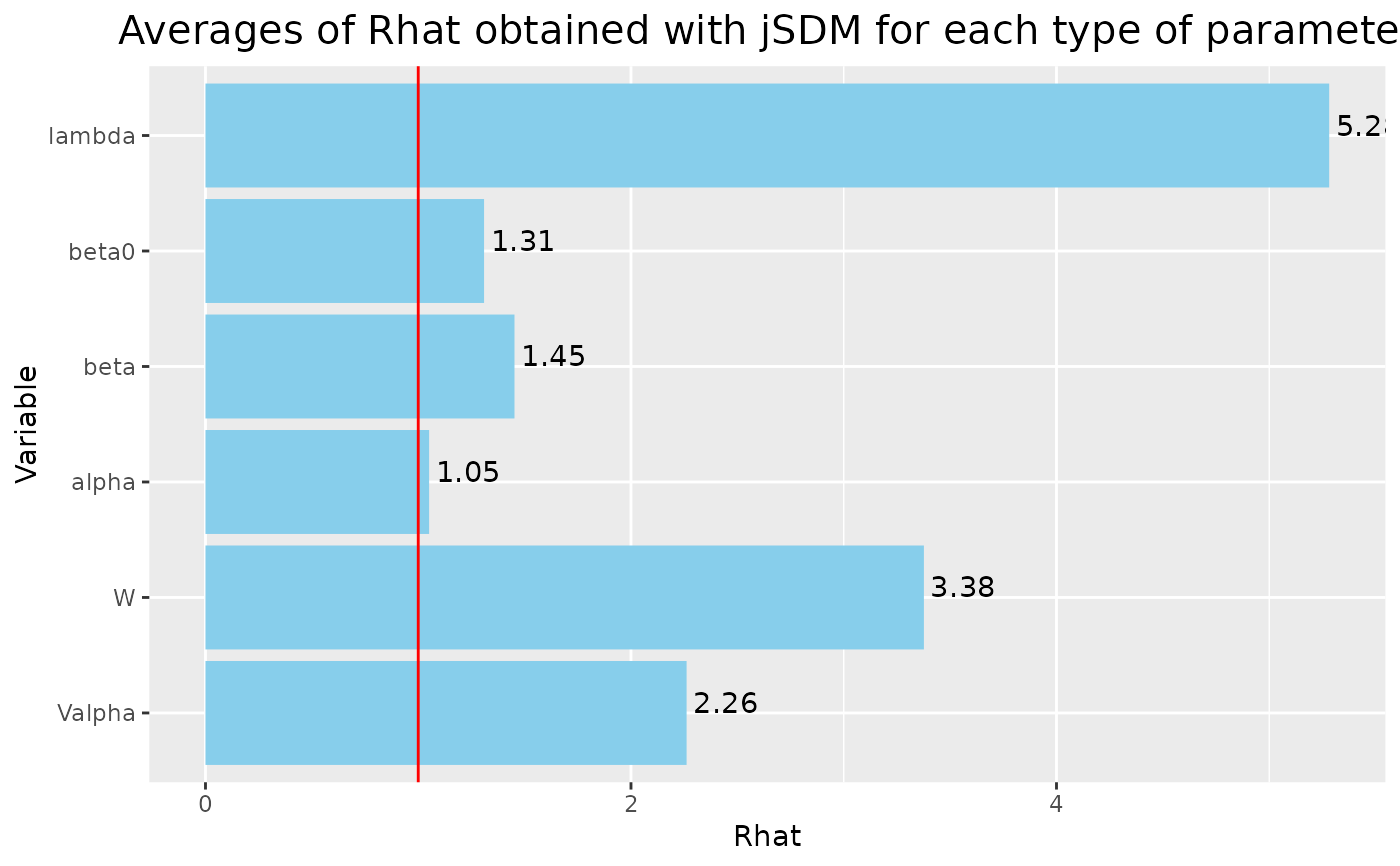 #= Parameter estimates
nchains <- length(mod)
## beta_j
pdf(file=file.path(tempdir(), "Posteriors_species_effect_jSDM_probit.pdf"))
plot(mcmc_list_param)
dev.off()
#> agg_record_1933144001
#> 2
## Latent variables
pdf(file=file.path(tempdir(), "Posteriors_latent_variables_jSDM_probit.pdf"))
plot(mcmc_list_lv)
dev.off()
#> agg_record_1933144001
#> 2
## Random site effect and its variance
pdf(file=file.path(tempdir(), "Posteriors_site_effect_jSDM_probit.pdf"))
plot(mcmc_list_V_alpha)
plot(mcmc_list_alpha)
dev.off()
#> agg_record_1933144001
#> 2
## Predictive posterior mean for each observation
# Species effects beta and factor loadings lambda
param <- list()
for (i in 1:nchains){
param[[i]] <- matrix(unlist(lapply(mod[[i]]$mcmc.sp,colMeans)),
nrow=nsp, byrow=TRUE)
}
par(mfrow=c(1,1))
for (i in 1:nchains){
if(i==1){
plot(t(beta.target), param[[i]][,1:np],
main="species effect beta",
xlab ="obs", ylab ="fitted")
abline(a=0,b=1, col='red')
}
else{
points(t(beta.target), param[[i]][,1:np], col=i)
}
}
#= Parameter estimates
nchains <- length(mod)
## beta_j
pdf(file=file.path(tempdir(), "Posteriors_species_effect_jSDM_probit.pdf"))
plot(mcmc_list_param)
dev.off()
#> agg_record_1933144001
#> 2
## Latent variables
pdf(file=file.path(tempdir(), "Posteriors_latent_variables_jSDM_probit.pdf"))
plot(mcmc_list_lv)
dev.off()
#> agg_record_1933144001
#> 2
## Random site effect and its variance
pdf(file=file.path(tempdir(), "Posteriors_site_effect_jSDM_probit.pdf"))
plot(mcmc_list_V_alpha)
plot(mcmc_list_alpha)
dev.off()
#> agg_record_1933144001
#> 2
## Predictive posterior mean for each observation
# Species effects beta and factor loadings lambda
param <- list()
for (i in 1:nchains){
param[[i]] <- matrix(unlist(lapply(mod[[i]]$mcmc.sp,colMeans)),
nrow=nsp, byrow=TRUE)
}
par(mfrow=c(1,1))
for (i in 1:nchains){
if(i==1){
plot(t(beta.target), param[[i]][,1:np],
main="species effect beta",
xlab ="obs", ylab ="fitted")
abline(a=0,b=1, col='red')
}
else{
points(t(beta.target), param[[i]][,1:np], col=i)
}
}
 par(mfrow=c(1,2))
for(l in 1:n_latent){
for (i in 1:nchains){
if (i==1){
plot(t(lambda.target)[,l],
param[[i]][,np+l],
main=paste0("factor loadings lambda_", l),
xlab ="obs", ylab ="fitted")
abline(a=0,b=1, col='red')
} else {
points(t(lambda.target)[,l],
param[[i]][,np+l],
col=i)
}
}
}
par(mfrow=c(1,2))
for(l in 1:n_latent){
for (i in 1:nchains){
if (i==1){
plot(t(lambda.target)[,l],
param[[i]][,np+l],
main=paste0("factor loadings lambda_", l),
xlab ="obs", ylab ="fitted")
abline(a=0,b=1, col='red')
} else {
points(t(lambda.target)[,l],
param[[i]][,np+l],
col=i)
}
}
}
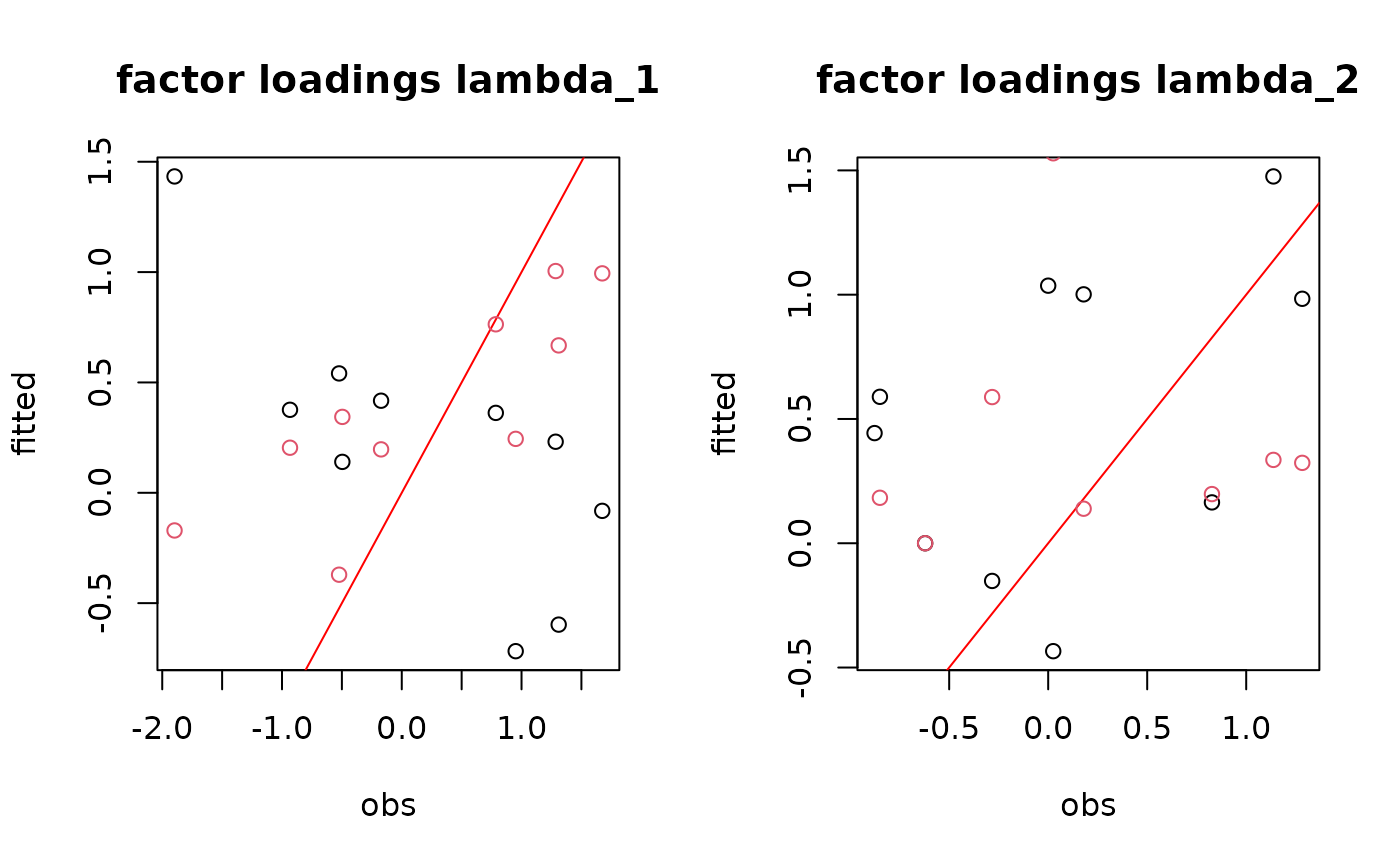 ## W latent variables
mean_W <- list()
for (i in 1:nchains){
mean_W[[i]] <- sapply(mod[[i]]$mcmc.latent,colMeans)
}
par(mfrow=c(1,2))
for (l in 1:n_latent) {
for (i in 1:nchains){
if (i==1){
plot(W[,l], mean_W[[i]][,l],
main = paste0("Latent variable W_", l),
xlab ="obs", ylab ="fitted")
abline(a=0,b=1, col='red')
}
else{
points(W[,l], mean_W[[i]][,l], col=i)
}
}
}
## W latent variables
mean_W <- list()
for (i in 1:nchains){
mean_W[[i]] <- sapply(mod[[i]]$mcmc.latent,colMeans)
}
par(mfrow=c(1,2))
for (l in 1:n_latent) {
for (i in 1:nchains){
if (i==1){
plot(W[,l], mean_W[[i]][,l],
main = paste0("Latent variable W_", l),
xlab ="obs", ylab ="fitted")
abline(a=0,b=1, col='red')
}
else{
points(W[,l], mean_W[[i]][,l], col=i)
}
}
}
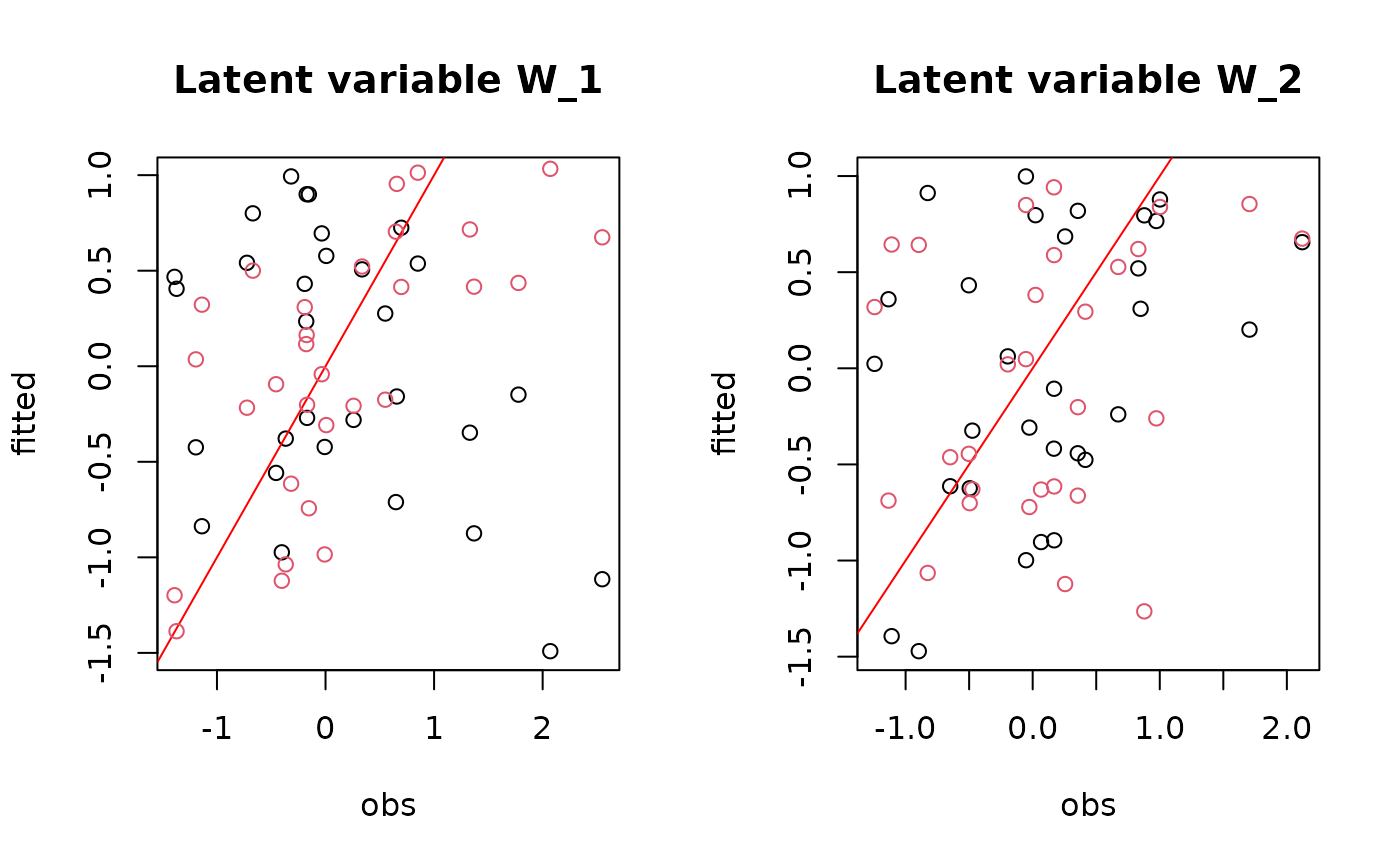 #= W.lambda
par(mfrow=c(1,2))
for (i in 1:nchains){
if (i==1){
plot(W%*%lambda.target,
mean_W[[i]]%*%t(param[[i]][,(np+1):(np+n_latent)]),
main = "W.lambda",
xlab ="obs", ylab ="fitted")
abline(a=0,b=1, col='red')
}
else{
points(W%*%lambda.target,
mean_W[[i]]%*%t(param[[i]][,(np+1):(np+n_latent)]),
col=i)
}
}
# Site effect alpha et V_alpha
plot(alpha.target,colMeans(mod[[1]]$mcmc.alpha),
xlab="obs", ylab="fitted",
main="Random site effect alpha")
abline(a=0,b=1, col='red')
points(V_alpha.target, mean(mod[[1]]$mcmc.V_alpha),
pch=18, cex=2)
legend("bottomright", legend=c("V_alpha"), pch =18, pt.cex=1.5)
for (i in 2:nchains){
points(alpha.target, colMeans(mod[[i]]$mcmc.alpha), col=i)
points(V_alpha.target, mean(mod[[i]]$mcmc.V_alpha),
pch=18, col=i, cex=2)
}
#= W.lambda
par(mfrow=c(1,2))
for (i in 1:nchains){
if (i==1){
plot(W%*%lambda.target,
mean_W[[i]]%*%t(param[[i]][,(np+1):(np+n_latent)]),
main = "W.lambda",
xlab ="obs", ylab ="fitted")
abline(a=0,b=1, col='red')
}
else{
points(W%*%lambda.target,
mean_W[[i]]%*%t(param[[i]][,(np+1):(np+n_latent)]),
col=i)
}
}
# Site effect alpha et V_alpha
plot(alpha.target,colMeans(mod[[1]]$mcmc.alpha),
xlab="obs", ylab="fitted",
main="Random site effect alpha")
abline(a=0,b=1, col='red')
points(V_alpha.target, mean(mod[[1]]$mcmc.V_alpha),
pch=18, cex=2)
legend("bottomright", legend=c("V_alpha"), pch =18, pt.cex=1.5)
for (i in 2:nchains){
points(alpha.target, colMeans(mod[[i]]$mcmc.alpha), col=i)
points(V_alpha.target, mean(mod[[i]]$mcmc.V_alpha),
pch=18, col=i, cex=2)
}
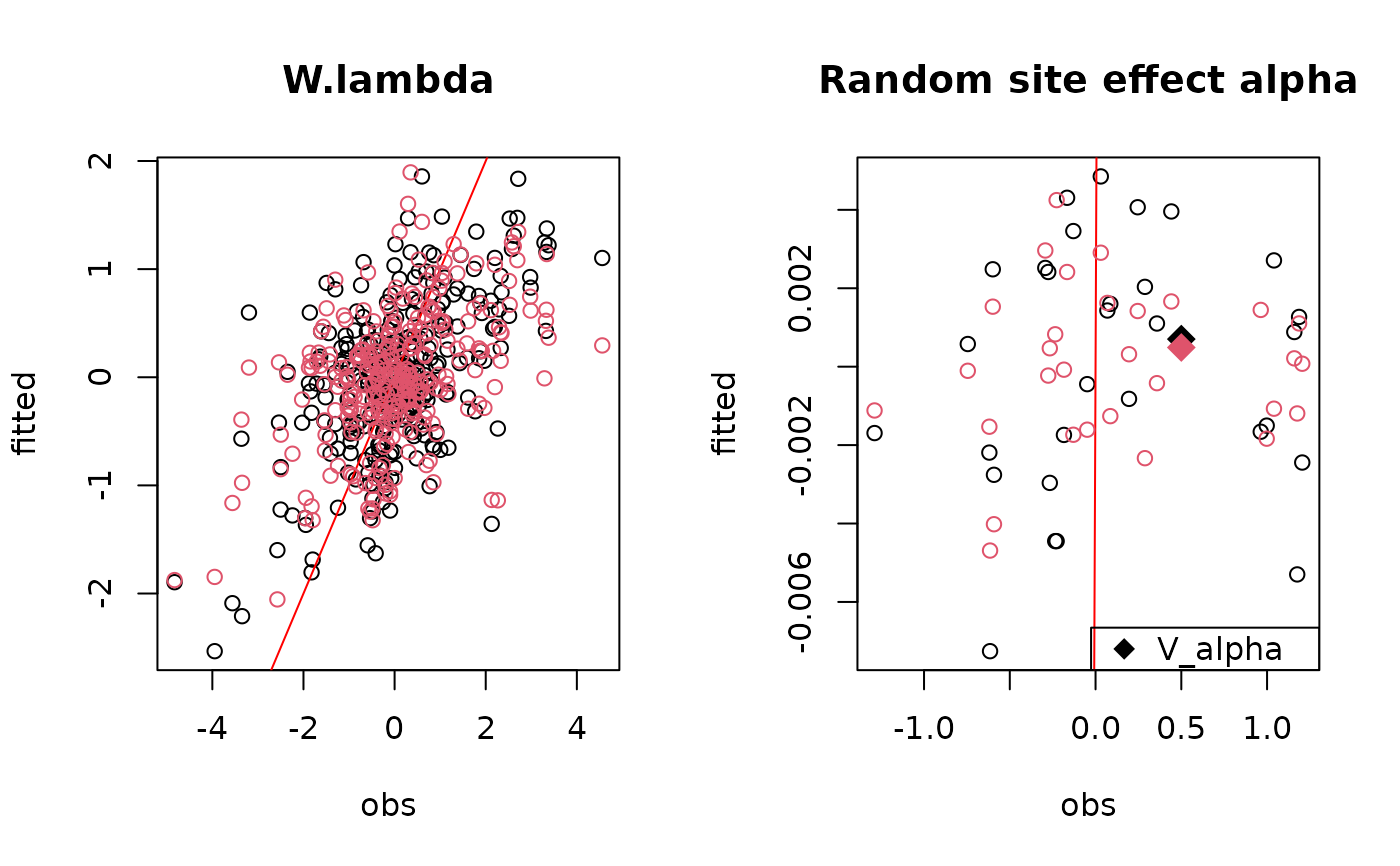 #= Predictions
## Occurence probabilities
plot(pnorm(probit_theta), mod[[1]]$theta_latent,
main="theta",xlab="obs",ylab="fitted")
for (i in 2:nchains){
points(pnorm(probit_theta), mod[[i]]$theta_latent, col=i)
}
abline(a=0,b=1, col='red')
## probit(theta)
plot(probit_theta, mod[[1]]$probit_theta_latent,
main="probit(theta)",xlab="obs",ylab="fitted")
for (i in 2:nchains){
points(probit_theta, mod[[i]]$probit_theta_latent, col=i)
}
abline(a=0,b=1, col='red')
#= Predictions
## Occurence probabilities
plot(pnorm(probit_theta), mod[[1]]$theta_latent,
main="theta",xlab="obs",ylab="fitted")
for (i in 2:nchains){
points(pnorm(probit_theta), mod[[i]]$theta_latent, col=i)
}
abline(a=0,b=1, col='red')
## probit(theta)
plot(probit_theta, mod[[1]]$probit_theta_latent,
main="probit(theta)",xlab="obs",ylab="fitted")
for (i in 2:nchains){
points(probit_theta, mod[[i]]$probit_theta_latent, col=i)
}
abline(a=0,b=1, col='red')
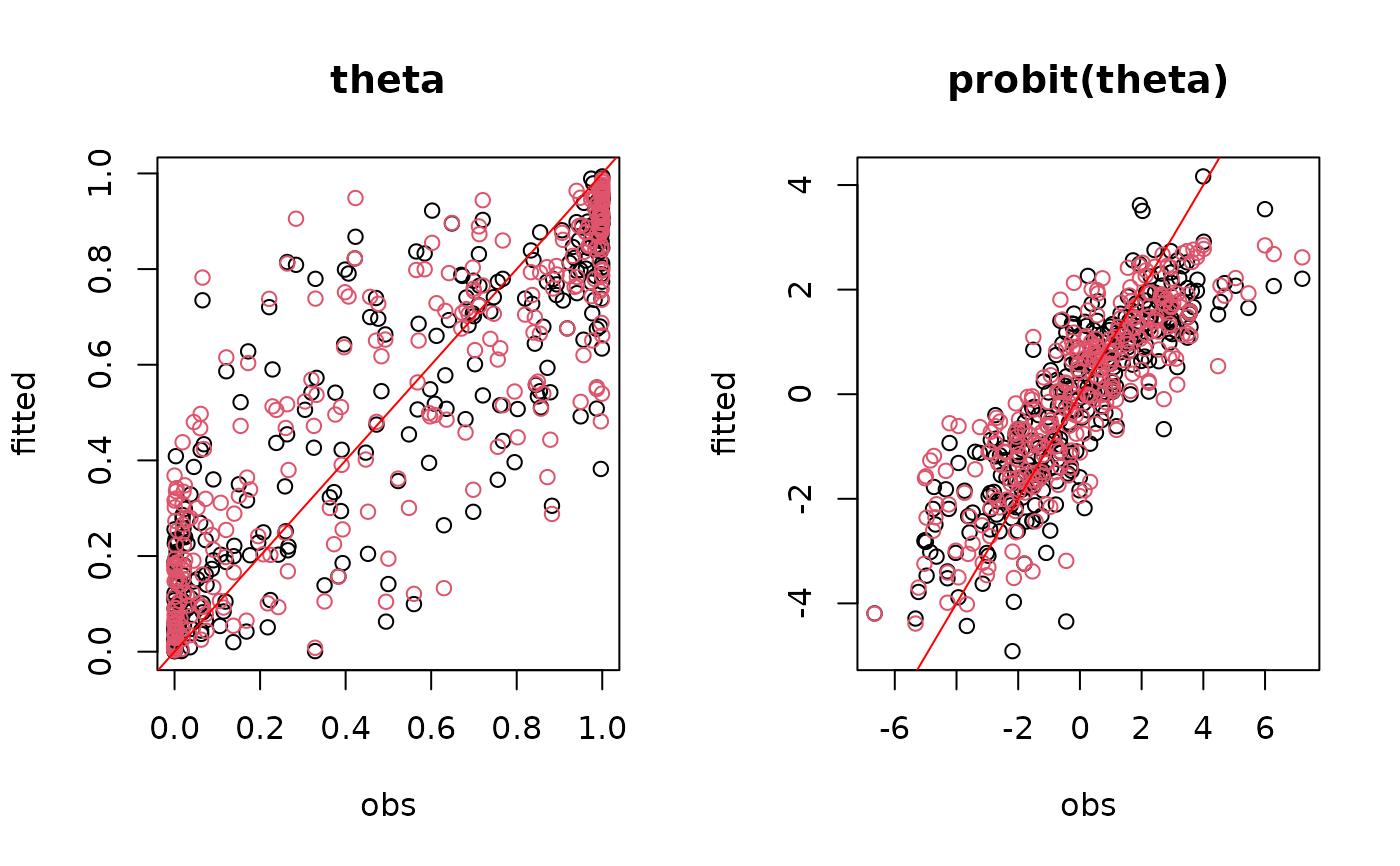 ## Deviance
plot(mcmc_list_Deviance)
## Deviance
plot(mcmc_list_Deviance)
 par(oldpar)
par(oldpar)